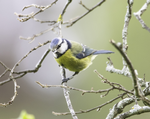
GARCÍA-NAVAS Vicente
Recommendations: 0
Review: 1
Review: 1

Identifying drivers of spatio-temporal variation in survival in four blue tit populations
Blue tits surviving in an ever-changing world
Recommended by Dieter Lukas based on reviews by Ana Sanz-Aguilar and Vicente García-NavasHow long individuals live has a large influence on a number of biological processes, both for the individuals themselves as well as for the populations they live in. For a given species, survival is often summarized in curves showing the probability to survive from one age to the next. However, these curves often hide a large amount of variation in survival. Variation can occur from chance, or if individuals have different genotypes or phenotypes that can influence how long they might live, or if environmental conditions are not the same across time or space. Such spatiotemporal variations in the conditions that individuals experience can lead to complex patterns of evolution (Kokko et al. 2017) but because of the difficulties to obtain the relevant data they have not been studied much in natural populations.
In this manuscript, Bastianelli and colleagues (2021) identify which environmental and population conditions are associated with variation in annual survival of blue tits. The analyses are based on an impressive dataset, tracking a total of almost 5500 adults in four populations studied for at least 19 years. The authors describe two core results. First, average annual survival is lower in deciduous forests compared to evergreen forests. The differences in average annual survival between the forest types link with previously described differences, with individuals having larger clutches (Charmantier et al. 2016) and higher aggression (Dubuc-Messier et al. 2017) in the populations where adult survival is lower. Second, there are huge fluctuations from one year to the next in the percentage of individuals surviving which occur similarly in all populations. Even though survival covaried across the four populations, this variation was not associated with any of the local or global climate indices the authors investigated.
Studies like these are fundamental to our understanding of population change. They are important from an applied side as they can reveal the sustainability of populations and inform potential management options. On a basic research side, they reveal how evolution operates in populations. Theoretical studies predict that individuals are often not adapted to average conditions they experience, but either selected to balance the extremes they encounter or to make the best during harsh conditions when it really matters (Lewontin & Cohen 1969).
This study also opens the door to new research, highlighting that demographic studies should pay attention to variation in survival and other life history traits. For blue tits specifically, the study shows that in order to understand the demography of populations we need a better mechanistic understanding of the environmental and physiological pressures influencing whether individuals die or not to make predictions whether and how climate or other ecological effects shape variation in survival.
References
Bastianelli O, Robert A, Doutrelant C, Franceschi C de, Giovannini P, Charmantier A (2021) Identifying drivers of spatio-temporal variation in survival in four blue tit populations. bioRxiv, 2021.01.28.428563, ver. 4 peer-reviewed and recommended by Peer community in Ecology. https://doi.org/10.1101/2021.01.28.428563
Charmantier A, Doutrelant C, Dubuc-Messier G, Fargevieille A, Szulkin M (2016) Mediterranean blue tits as a case study of local adaptation. Evolutionary Applications, 9, 135–152. https://doi.org/10.1111/eva.12282
Dubuc-Messier G, Réale D, Perret P, Charmantier A (2017) Environmental heterogeneity and population differences in blue tits personality traits. Behavioral Ecology, 28, 448–459. https://doi.org/10.1093/beheco/arw148
Kokko H, Chaturvedi A, Croll D, Fischer MC, Guillaume F, Karrenberg S, Kerr B, Rolshausen G, Stapley J (2017) Can Evolution Supply What Ecology Demands? Trends in Ecology & Evolution, 32, 187–197. https://doi.org/10.1016/j.tree.2016.12.005
Lewontin RC, Cohen D (1969) On Population Growth in a Randomly Varying Environment. Proceedings of the National Academy of Sciences, 62, 1056–1060. https://doi.org/10.1073/pnas.62.4.1056